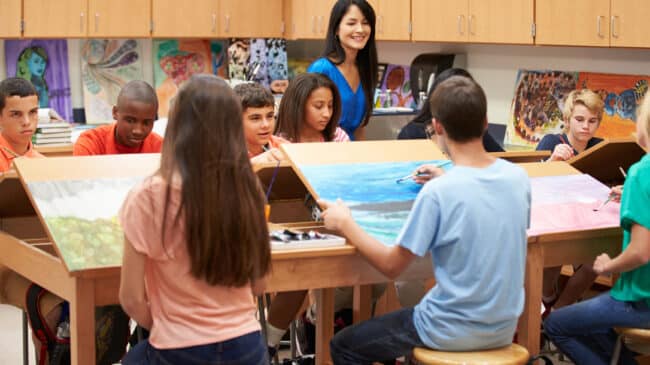California’s Proposition 28 on the November 2022 ballot would create dedicated annual funding for arts and music programming and personnel in schools by requiring the state to dedicate at least 1% of annual state and local revenues that local education agencies (traditionally a public board of education) receive under Proposition 98 (1988).
Prop. 28 would also direct a higher proportion of this dedicated funding to schools with a concentration of low-income students. Larger schools, with 500 or more student, would have to use 80% of the funding for employing teachers and 20% for training and materials.
Fiscal Impact
Proposition 28 would require education funding in addition to the state’s Proposition 98 minimum guarantee. Therefore, according to the California Legislative Analyst’s Office, public school spending in the state would likely increase between $800-$1 billion annually in 2023-24 if passed. The LAO finds, “Beginning next year, Proposition 28 would increase state costs by about $1 billion annually. This amount is less than one-half of 1 percent of the state’s total General Fund budget. The additional funding would be considered a payment above the constitutionally required amount of funding for public schools and community colleges.”
Proponents’ Arguments For
Few places conjure the image of the creative economy like California. Former education policymakers Arne Duncan and Austin Beutner wrote in CalMatters that this status, however, rests on tenuous ground. They claim that only “1 in 5 public schools in California has a dedicated teacher for traditional arts programs like music, dance, theater and art, or newer forms of creative expression like computer graphics, animation, coding costume design and filmmaking.”
The campaign for “Yes on 28” warns that across grade levels, 90% of elementary schools, 96% of middle schools, and 72% of high schools in California are not providing a high-quality course of study across arts disciplines.
A decline in arts programming may be due to prolonged underfunding, supporters of Prop 28 say. Without raising taxes, Prop 28 supporters hope to reserve 1% of combined state and local education spending for developing and maintaining arts education.
Accountability would be ensured through both spending restrictions and reporting requirements. School officials could only spend the new revenue on arts teachers, classified personnel, and teaching aides. Annual reporting from each school district would require details on arts programs, including student participation levels.
Supporters expect Prop. 28 to not only increase student engagement, cognitive development, and creative and critical thinking skills but also equip students for good-paying jobs. This could be especially critical to students from families struggling financially. For this reason, advocates included additional curriculum funding for schools serving low-income communities.
Advocates further argue, that when compared to other high-cost states, such as New York, California lags in education per-pupil spending overall. While there may not be the political will for a tax increase to fund arts education, simply prioritizing existing spending not only reflects the values of California, in their mind but invests in its future workforce, supporters say.
Opponents’ Arguments Against
In 1988, voters passed Proposition 98 requiring roughly 40% of California’s general funds to be spent on public schools and community colleges. Proposition 28, if passed, will require additional education spending on top of Proposition 98’s minimum guarantee.
California already spends $95.5 billion on its public school system, translating to around $17,000 per student. This figure puts California in the top 10 states for per-student education funding. California’s current spending on K-12 education has reached a historic high, while public school enrollment is the lowest in two decades. Prop. 28 opponents wonder whether this level of spending can be sustained, especially if the student population continues to drop.
Prop. 28 opponents such as Reform California further warn of locking in nearly $1 billion of education spending through an earmark that may come at the expense of other education spending priorities. A mandate on arts spending would be unique, as no such mandate exists for math, science, reading, or physical education, opponents say.
Locking in spending requirements could also reduce financial flexibility when leaders respond to education policy under new economic and social changes over time, including public school enrollment decline. Leaders would have fewer resources to address the state’s backlog of debt or the next economic downturn.
Discussion
California is no stranger to financing arts education through its state budget. Tens of millions of dollars are appropriated annually for arts initiatives. Visual and performing arts instruction, including music, is currently required for all students in grades 1-6, and schools are required to provide these courses to 7th-8th grade students as electives.
To graduate from a California high school, students must choose to complete a year’s course work in visual or performing arts, a foreign language, or most recently, career technical education.
Each local school board may set additional graduation requirements. For example, a 2017 study found nearly half of the state’s school districts prohibit swapping a year’s course work in visual or performing arts with a foreign language or career technical education. This change sought to reflect California public university admission requirements, which demand a year of exclusively visual or performing arts education credit.
If Prop. 28 passes, a 1% combination of state spending, in addition to the spending of each locality through property taxes, would be solely dedicated to music and arts education. Based on previous year enrollment figures, 70% of this newly authorized spending would be distributed among California school districts. The remaining 30% would be reserved for school districts based on their proportion of economically disadvantaged students. Among California’s six million public school students, 60% come from low-income families.
While laws in California require arts education to be included, to varying degrees, across students’ public school careers, Proposition 28 would create the first-ever revenue stream dedicated to these programs exclusively. This creates a tradeoff between a value for arts education and a value for local control by schools over how to use resources. If the primacy of local control is retained, students, parents, and other advocates can make the case in their own school communities about spending priorities, including the arts. There is no guarantee, either, that this new influx of spending will improve student academic or social outcomes. Higher spending in the public school system has largely failed to guarantee greater student achievement.
Voters’ guides for other propositions on California’s 2022 ballot.

